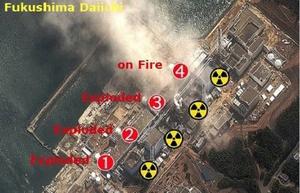Lessons of FukushimaFukishima's valuable lessons for future nuclear power plants
Among the lessons to be learned from the accident at Japan’s Fukushima Daichii nuclear power plant are that emergency generators should be better protected from flooding and other extreme natural events, and that increasing the spacing between reactors at the same site would help prevent an incident at one reactor from damaging others nearby

The Fukushima disaster provides important safety lessons // Source: japonation.com
Among the lessons to be learned from the accident at Japan’s Fukushima Daichii nuclear power plant, according to a new report from MIT, are that emergency generators should be better protected from flooding and other extreme natural events, and that increasing the spacing between reactors at the same site would help prevent an incident at one reactor from damaging others nearby.
The new report, an update of a preliminary report issued in May, wasput out this month by MIT’s Department of Nuclear Science and Engineering (NSE), is available for download on the NSE Web site.
“A lot of information that was not available when we started has become available,” says Jacopo Buongiorno, the Carl Richard Soderberg Associate Professor of Power Engineering and lead author of the new report, which was co-authored by eight other members of the NSE faculty. He adds, however, that there are some important areas where information has still not come out.
AN MIT release quotes Buongiorno to say that during the first days of the accident there were three critical delays that have not yet been well explained — although the report says there is no evidence at this point of any major human errors contributing to the unfolding problems. The delays involved operating some safety-critical valves, injecting water into the reactor cores, and venting the containment buildings. “It’s not clear what the cause of the delays was,” Buongiorno says, but it is unlikely that these were caused by administrative delays in Japan’s control-and-command chain, as had been initially suggested.
Rather, because of the lack of power and the effects of the flooding, “there was disruption and confusion around the site” during the crucial early hours, he says. “Things that normally would take minutes, such as reading an instrument or connecting a cable or a hose, took hours” because of the lack of power and the debris and destruction. “Given the situation, they reacted as well as they could,” he says.
Among the specific suggestions the report makes:
- Emergency backup generators, needed to keep the systems running when outside power is cut off as it was in this case, should be well separated into at least two locations — one situated high up, to protect against flooding, and the other down low to protect against hazards such as an airplane crash. These generators should also be housed in watertight rooms, as they already are at many U.S. plants.
- In future plants, spacing between reactor buildings located at the same site should be increased — for example, by having other areas such as parking lots or support buildings in between — and systems such as ventilation shafts should be kept separate, in order to avoid a domino-like spread of problems from one reactor to another. In the Fukushima accident, it seems that hydrogen vented from reactor unit 3 may have reached unit 4 through the ventilation system, causing an explosion there.
- Officials should be cautious about decisions to evacuate large areas around a damaged nuclear plant in cases where the population has already been devastated by a natural disaster. At Fukushima, “ironically, the biggest [health] consequences may be from the prolonged evacuation,” said Jacopo Buongiorno, the Carl Richard Soderberg Associate Professor of Power Engineering and lead author of the new report.
- More attention needs to be paid to how radiation risks are communicated to the public, rather than the confusing mix of different measurements that were disseminated in this case. The most useful standard is to relate radiation releases to natural background levels, rather than using technical units unfamiliar to most people.
The most obvious piece of advice — and one that is already observed in the majority of new nuclear-plant installations worldwide — is that in locating future plants it would be wise to “choose sites away from highly seismic areas and coasts,” to reduce the risks from earthquakes, tsunamis and floods.
